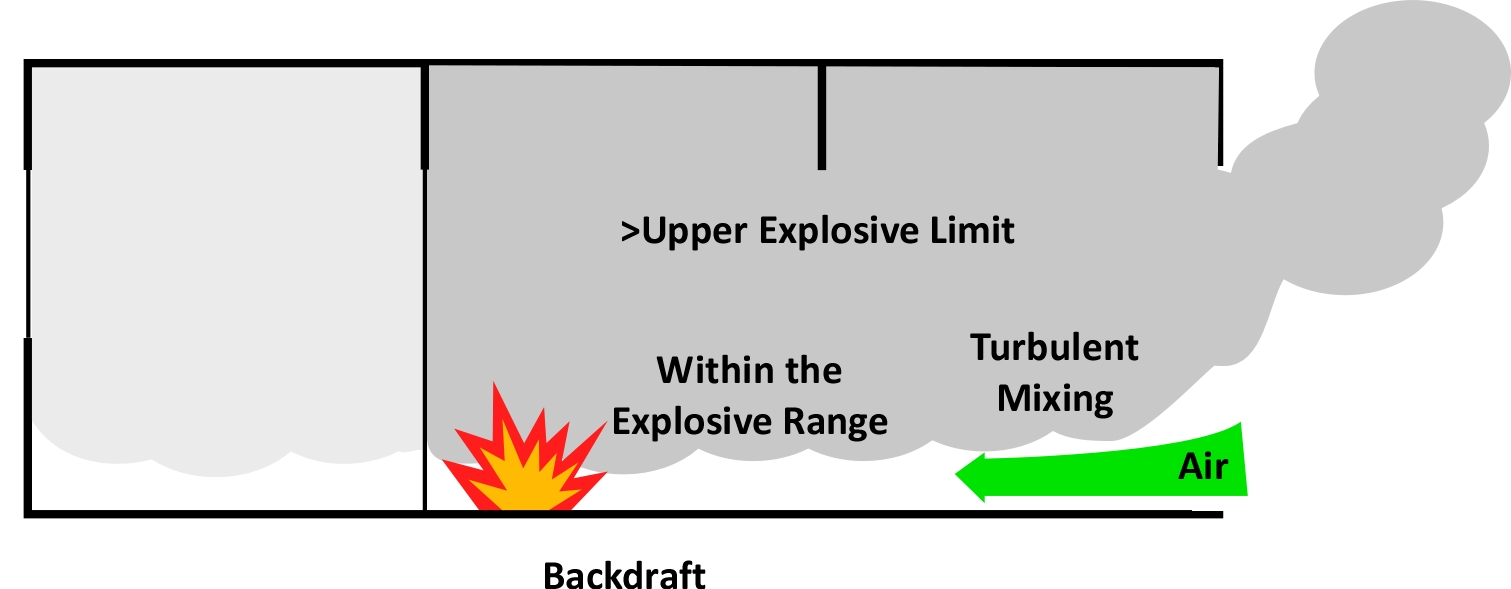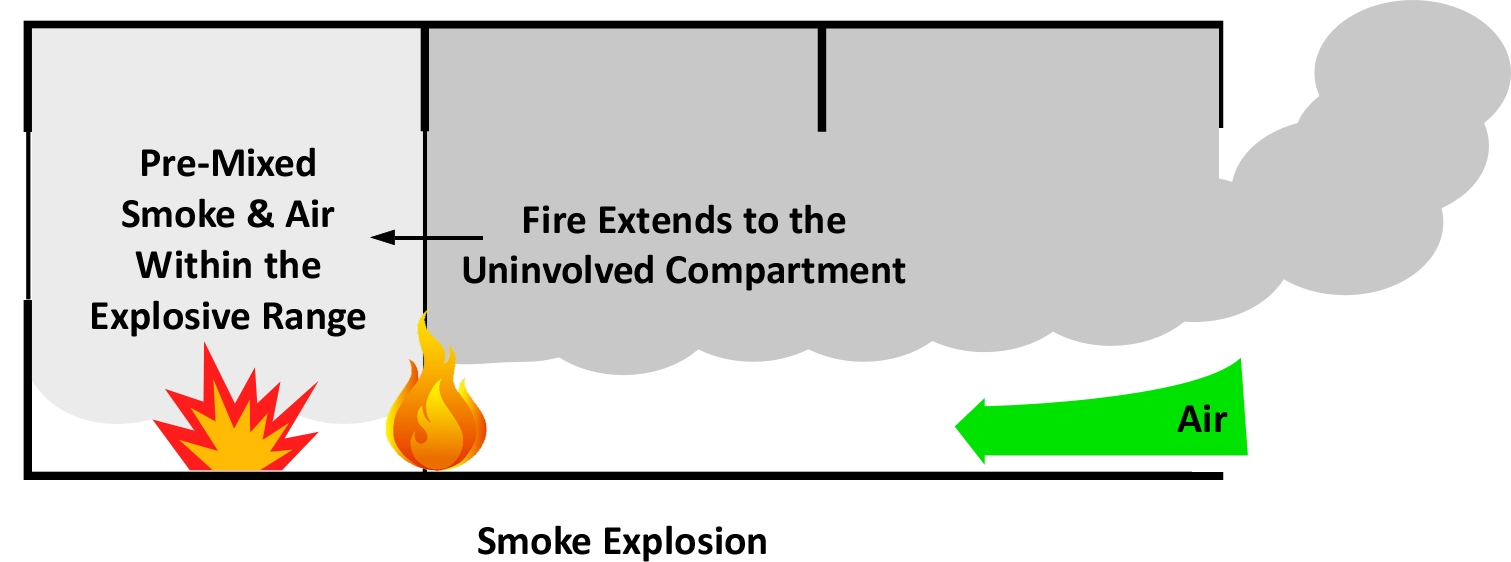What’s the Difference?

The fire behavior phenomena backdraft and smoke explosion are often confused. This is no surprise given that the National Fire Protection Association (NFPA) 921 Guide for Fire and Explosion Investigations (NFPA, 2024) and NFPA 1700 Guide for Structural Fire Fighting (NFPA, 2022) provide different, and decidedly ambiguous definitions for these two phenomena.
Both NFPA 921 and NFPA 1700 define backdraft as “a deflagration resulting from the sudden introduction of air into a confined space containing oxygen-deficient products of incomplete combustion” (NFPA, 2024, 3.3.19 & NFPA, 2022, 3.3.6). Is there anything missing from this definition?
“Oxygen deficient products of combustion” are encountered anytime that a fire in an enclosure is ventilation limited. However, while the introduction of air to a ventilation limited fire (absent concurrent application of water for fire control) will result in an increase in heat release rate, it does not always result in a backdraft. For a backdraft to occur there must be a rich mixture of products of pyro9lysis and incomplete combustion within the enclosure. In addition, there must be a source of ignition to ignite this gas phase fuel as it mixes with air, creating mixture within the flammable range at the boundary of the fuel and incoming air.
NFPA 921 and NFPA 1700 define smoke explosion differently. NFPA 921 has over multiple revisions has indicated that backdraft and smoke explosion are the same thing. The current edition of NFPA 911 provides the following definition “see 3.3.19, Backdraft” (NFPA, 2024, 3.3.183). On the other hand, NFPA 1700 defines smoke explosion as “a rapid fire development that occurs when a smoke-air mixture falls within its flammable range, either external or internal to the room of origin, and is ignited, resulting in a significant pressure front (NFPA, 2022, 3.3.187).
Backdraft and smoke explosion are both fire behavior related explosions but are significantly different from one another. For a deeper dive, see Backdraft: Fire Science and Firefighting, A Literature Review (Lambert, 2014) and continue following this series of Command Competence blog posts on Backdraft and Smoke Explosion.
Backdraft is a deflagration (explosion) resulting from increased ventilation of an enclosure containing a concentration of atmospheric oxygen that is too low to support significant flaming combustion and a high concentration of flammable products of combustion and unburned pyrolysis products (smoke) above their flammable range. Backdraft requires a change in ventilation. The deflagration begins inside the enclosure as mixing of smoke and air results in a mixture that is within the flammable range where the mixing is occurring.

It is important to note that increasing ventilation to a ventilation limited fire (absent application of water for fire control) will always result in an increase in heat release rate (HRR) but does not always result in a backdraft. In some cases, increased ventilation will result in a ventilation induced flashover and in other cases it simply will result in the fire becoming larger (increased HRR).
There are two related conditions required for the occurrence of a backdraft, a high concentration of flammable products of combustion and unburned pyrolysis products and a low concentration of oxygen (these two conditions are directly related). In addition, there needs to be a source of ignition, such as smoldering fuel that returns to flaming combustion as air flows into the room.
Recognizing potential for a backdraft is challenging. There are multiple indicators that may (or may not) indicate backdraft potential. Backdraft indicators include:
- A ventilation limited fire (necessary for production of a significant quantity of flammable products of combustion and unburned pyrolysis products)
- Pulsing air track (flow). Discharge of smoke followed by intake of air (absence of smoke discharge). The frequency of pulsation can vary considerably and there may be a significant delay between cycles.
- Condensed pyrolysis products on windows (brown, grey, or black are common colors for this condensate).
- No visible flames (this can be misleading as conditions can vary considerably in different areas of a building under fire conditions).
- Significant heat indicators (this is an indirect indicator, but significant heat is necessary to produce a high concentration of pyrolysis products).
- Backdrafts can occur with varied smoke colors (consider this indicator with caution). Yellowish brown smoke has traditionally been considered an indicator, but backdrafts have occurred with creamy whiteish, brown, and black smoke.
- High optical density (thickness) and the texture of smoke (looking like velvet) is consistent with extremely ventilation limited conditions and potential for backdraft.
- Whistling sounds resulting from high velocity smoke discharge (this may be a late indicator).
- High velocity intake of air when making an opening (remember that entry openings are also ventilation openings). This is a late indicator!
It is essential to consider all fire behavior indicators holistically and recognize patterns of interrelated indicators. The preceding list of indicators points to potential, not certainty of a backdraft.
Smoke explosion is a deflagration resulting from ignition of atmospheric oxygen, flammable products of combustion, and unburned pyrolysis products (smoke) that are within their flammable range. Smoke explosions most commonly occur in smoke logged compartments or void spaces remote from the fire. The ignition source may be extension of fire into the compartment or void space, or it may be unrelated to the fire. A flammable mixture of smoke and air may develop as smoke is mixed with air in uninvolved compartments or void spaces or it may develop as ventilation of uninvolved compartments or void spaces reduces a fuel rich concentration of smoke and air to within the flammable range.

One of the most concerning things about smoke explosions is a lack of distinct indicators for potential occurrence of this phenomenon. Other than the presence of smoke in areas remote from the fire, which is a normal condition during a structure fire there are no clearly distinct indicators of potential for a smoke explosion.
Potential indicators of a smoke explosion include:
- A ventilation limited fire (necessary for production of a significant quantity of flammable products of combustion and unburned pyrolysis products).
- Void spaces where smoke may accumulate remote from the fire (such as attics, cocklofts, suspended ceilings, and behind knee walls).
- Smoke travel to remote areas of the building or from the main fire occupancy into attached exposures.
- Potential for fire extension from areas currently involved into remote areas of void spaces.
As with indicators of potential backdraft, indicators of potential for a smoke explosion must be considered wholistically and recognize patterns of interrelated indicators.
Really understanding the difference between backdrafts and smoke explosions requires an understanding of several basic concepts of fire dynamics. Next Monday’s post will go back to the beginning and look at fuel, the relationship of oxygen and heat release, products of combustion and fire development. While these concepts are basic, they form the foundation for understanding the fire behavior phenomena of backdraft and smoke explosion.
References
Lambert, K. (2014). Backdraft: fire science and firefighting, a literature review. Retrieved April 11, 2025, from https://bit.ly/3Et9Do5.
National Fire Protection Association (NFPA). (2024). NFPA 921 Guide for Fire and Explosion Investigations. Quincy, MA: Author.
National Fire Protection Association (NFPA). (2022). NFPA 1700 Guide for Structural Fire Fighting. Quincy, MA: Author.